 Mysteries
Mysteries  Mysteries
Mysteries  History
History 10 Surprising Stories About the Texas Rangers
 Humans
Humans 10 Philosophers Who Were Driven Mad by Their Own Theories
 Miscellaneous
Miscellaneous 10 Video-Game-Worthy Weapons and Armors from History
 Weird Stuff
Weird Stuff 10 Psychics Who Accurately Predicted Wartime Events
 The Arts
The Arts 10 Pieces of Art Inspired by a Broken Heart
 Health
Health 10 Science Fiction-Sounding New Medical Treatments
 History
History 10 Surprising Facts About the Father of Submarine Warfare
 Space
Space Ten Astonishing New Insights into Alien Worlds
 Weird Stuff
Weird Stuff 10 Bizarre Summer Solstice Rituals Still Practiced Today
 Mysteries
Mysteries Top 10 Haunting Facts About the Ghost Ship MV Alta
 History
History 10 Surprising Stories About the Texas Rangers
 Humans
Humans 10 Philosophers Who Were Driven Mad by Their Own Theories
Who's Behind Listverse?

Jamie Frater
Head Editor
Jamie founded Listverse due to an insatiable desire to share fascinating, obscure, and bizarre facts. He has been a guest speaker on numerous national radio and television stations and is a five time published author.
More About Us Miscellaneous
Miscellaneous 10 Video-Game-Worthy Weapons and Armors from History
 Weird Stuff
Weird Stuff 10 Psychics Who Accurately Predicted Wartime Events
 The Arts
The Arts 10 Pieces of Art Inspired by a Broken Heart
 Health
Health 10 Science Fiction-Sounding New Medical Treatments
 History
History 10 Surprising Facts About the Father of Submarine Warfare
 Space
Space Ten Astonishing New Insights into Alien Worlds
 Weird Stuff
Weird Stuff 10 Bizarre Summer Solstice Rituals Still Practiced Today
10 Bizarre Origin Stories About Your Favorite Foods
Food is the one constant that binds us all. Every culture has its own style of cooking. We assume that staple items in our own cuisine have a deep history in our culture.
Shockingly, some of the foods we eat every day have wildly bizarre origin stories that you would never guess. From the almost “Belgian fry” to a recipe brought to life by a spirit-walking nun, this list will have you thinking about the food you eat in a whole new light.
10 Ketchup
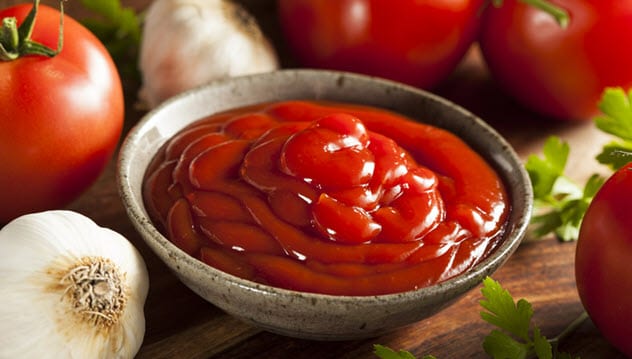
Ketchup is perhaps the American standard in condiments. It is a highly popular topping for hot dogs and hamburgers and the dipping sauce of choice for most everything, especially for kids.
It is so popular that 97 percent of US households report having it in the fridge. Clearly an all-American product, right?
Surprisingly, the origin of ketchup is actually Chinese. The word “ketchup” comes from a Hokkien Chinese word ke-tsiap, which was a sauce derived from fermented fish that was wildly popular in southeastern China.
The British drew inspiration from this sauce and began attempting to replicate it at home. This was indicated by a recipe for “ketchup in paste” published in 1732 by Richard Bradley. It listed “Bencoulin in the East Indies” as its origin.
However, this was far from the ketchup that we know and love today. Eventually, a man named Henry J. Heinz got involved and started producing his own ketchup recipe in 1876. The rest, as they say, is history.[1]
9 Fried Chicken
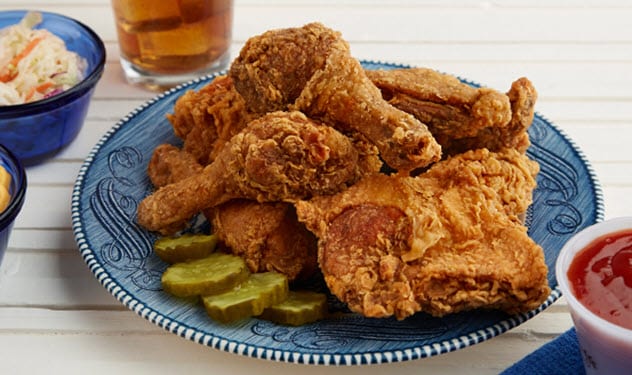
Fried chicken is another deeply rooted standard. In fact, if you told most people that fried chicken was invented anywhere but in the American South, you’d have a riot on your hands.
With all due apologies to Colonel Sanders and the 11 herbs and spices in his “Original Recipe,” fried chicken was actually invented in—yup, you guessed it—Scotland! Okay, so you probably didn’t guess that because Scotland isn’t exactly synonymous with fried chicken. But it’s the truth.
In medieval times, the Scots were among the only people who preferred to cook their chicken in hot fat in a method we now know as “frying.” In the 1800s, many Scottish immigrants came to the United States, widely populating the American South and bringing the dish to prominence.[2]
Of course, they were helped by African slaves who turned the dish into the delight we know today and gave it life as a deeply rooted soul food staple.
8 Pancakes

No modern-day food could have been popular over 30,000 years ago, right? Well, researchers have actually found pancakes in the stomach of Otzi the Iceman, a corpse dating back 5,300 years.
In ancient Greece and Rome, pancakes were made from a mixture of honey, wheat flour, olive oil, and curdled milk. During the English Renaissance, the popular breakfast dish was flavored with apple, sherry, rosewater, or spices.[3]
Thomas Jefferson loved pancakes so much that he sent a recipe for specialty pancakes to his hometown from the White House.
7 Bacon
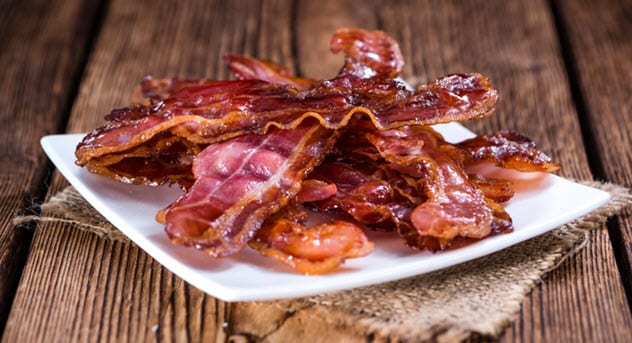
Unsurprisingly, bacon has been bringing joy to people’s lives since 1500 BC. What is surprising is that it originated in ancient China. At that time, the Chinese were curing pork bellies with salt and giving birth to arguably the most important historical invention in the world: bacon.
Eventually, through their conquests, the Romans and the Greeks learned of the curing process and began manufacturing their own bacon. The ancient Romans’ early form of bacon was known as petaso, which was a pork shoulder boiled with dried figs, browned, and served with wine.
The word “bacon” is thought to have many possible origins—the French word bako, the Germanic word bakkon, and the old Teutonic word backe. All of them reference the back of a pig.
In the 17th century, they finally got it right. The word “bacon” evolved to mean the salted, smoked pork belly that we know and love today.[4]
6 Mac And Cheese
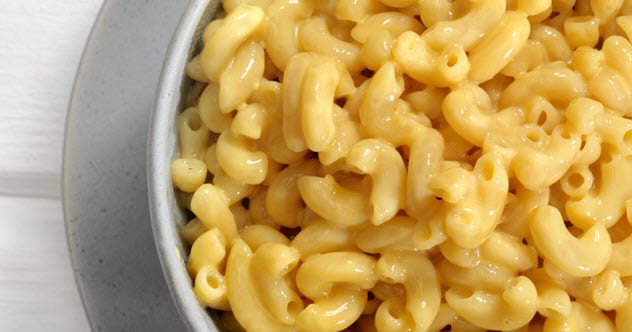 Macaroni blended with a melty cheese sauce (sometimes topped with decadent lobster or, even better, bacon) is another guilty pleasure comfort food. As it’s pasta related, it’s no surprise that this dish has roots in Italy.
Macaroni blended with a melty cheese sauce (sometimes topped with decadent lobster or, even better, bacon) is another guilty pleasure comfort food. As it’s pasta related, it’s no surprise that this dish has roots in Italy.
However, the dish served there is a far cry from the meal that Kraft released in a box in 1937. In fact, the mac and cheese that existed prior to the 1300s in southern Italy was more of a lasagna. That recipe called for pasta sheets boiled in water and layered with grated cheese and spices.[5]
“American mac and cheese” has far more humble roots. Like most good origin stories, however, it is muddled with controversy. According to some, mac and cheese was invented as a casserole dish to bring to New England church suppers. This story gives credit to the fact that the dish was known for a long time as “macaroni pudding.”
According to others, Thomas Jefferson (apparently a food lover) brought a pasta machine back from Italy and his wife used it to create the dish with Parmesan, which Jefferson later substituted with cheddar. The one fact that can’t be disputed, however, is that macaroni and cheese is a delicious dinner that you can make on a budget.
5 The Hamburger
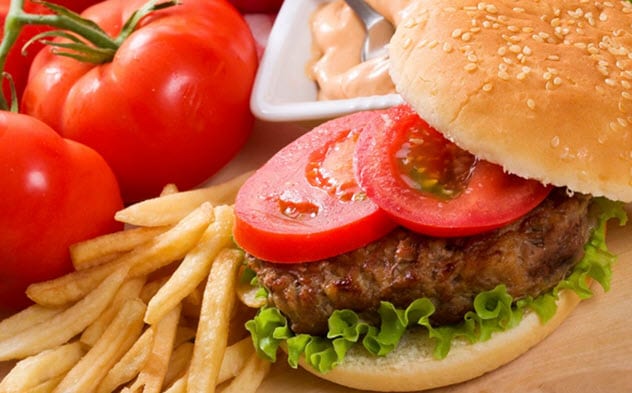
Common knowledge tells us that the hamburger was invented in Hamburg, Germany, in the 19th century, but that’s only partially true. Meat from the Hamburg cow was minced, combined with spices, and formed into a patty (which is traditionally known as a “Hamburg steak”).
This was considered an upscale meal in the early days as just a spiced meat patty with no bun was one of the more expensive items on high-end restaurant menus. However, real bun-covered hamburgers didn’t come around until quite a while later.
In fact, they didn’t really evolve into sandwich form until the Industrial Revolution. During that time, factory workers were served hamburger steaks from a food cart. One brilliant soul, whose name is lost in history, started putting the meat between two pieces of bread to make it easier to eat while working—and viola! The modern-day hamburger was born.[6]
4 The Hot Dog

Ah yes, another iconic American food that isn’t even American. Hot dogs were invented in Germany. Of course, they were called “dachshund” or “little dog” sausages there. These terms referred to this sausage being smaller and thinner than traditional German sausages.
The man behind the invention of these sausages was Johann Georghehner. He took his product to Frankfurt to market it, giving birth to the term “frankfurter.”[7]
So, how did “frankfurter” become “hot dog”?
Well, in a shocking twist, the name was coined by drunken college kids, or so the theory goes. Frankfurters were incredibly popular because they were cheap and easy to eat. Somehow, one budding collegiate genius figured out the origin of the hot dog and that its initial name in German referred to a “little dog.”
That led him (or her) to start the rumor that hot dogs were made from dog meat. Somehow, this funny theory increased the popularity of the frankfurter, and the name “hot dog” stuck.
3 French Fries

They’re called “french fries,” so they must be French, right? Turns out, they may not be.
One competing theory suggests that the golden, fried, crispy potatoes were originally made in Belgium. Villagers near the Meuse River often ate fried fish as a staple dish. In the winter, the rivers would freeze, cutting off access to the fish, so they would fry potatoes for their meals instead.
It’s rumored that US soldiers stumbled upon this. As the predominant language in that part of Belgium was French, the soldiers dubbed the food “french fries.”
Like any good origin story, there is a third theory. Some believe that the “french fry” is really Spanish. The Spanish were the first-recorded people to encounter the South Americans as mentioned in The Chronicle of the Incas, or the Seventeen-Year Travel of Pedro Cieza de Leon Throughout the Mighty Kingdom of Peru. This was written by Pedro Cieza de Leon as a memoir.[8]
No matter what the truth is, “french fry” sounds much better than “Belgian fry” or “Spanish fry.” So we’ll stick with it as is.
2 Chili
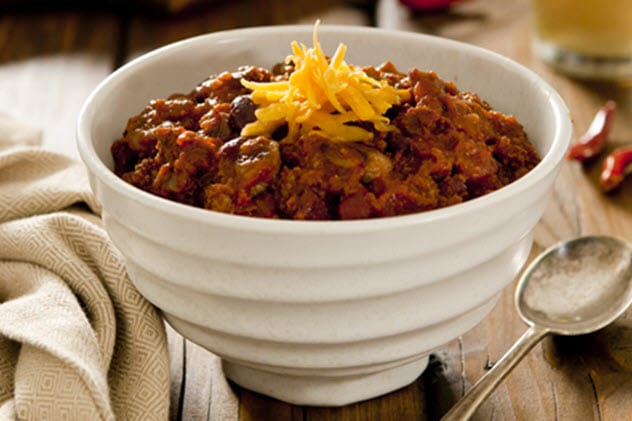
Are you ready for a creepy nun origin story?
According to a Native American legend, a nun is responsible for the first chili recipe recorded on paper. Apparently, Sister Mary of Agreda of Spain would go into a trance, leaving her lifeless body behind for days. Shadow-walking into different cultures, she used her soul to preach to “savages” and encouraged them to seek out Spanish Christian missions.
Although the corporeal Sister Mary never left the confines of Spain, it is believed that she spirit-walked across the globe. The Native Americans refer to her as la dama de azul (“the lady in blue”).[9]
But we’re a bit skeptical here. A nun spirit-walks across the globe in an era when intercultural communication doesn’t yet exist and the most famous information she brings back is a recipe for chili? Must be one divine recipe.
1 Chocolate Chip Cookies

Always good to end with a dessert. The chocolate chip cookie is a classic offering in that category. Whoever conceptualized this must have been a visionary.
As it turns out, the chocolate chip cookie was the product of a happy accident. Ruth Graves Wakefield ran an inn in Massachusetts called the Toll House Inn. She and her husband were getting ready to bake some Chocolate Butter Drop Do cookies, a colonial favorite, when Ruth realized that she was out of baking chocolate.
Earlier in the week, she had been given a block of Nestle semisweet chocolate from Andrew Nestle himself. She decided to chop that up and use it as a substitute. Instead of dissolving into the batter during the baking process, the chocolate chunks held their form, resulting in the most delicious accident in US history.[10]
Eric Falvey is a US-born author. His comedy novel, The Book of Roderick Medieval Mayhem, is currently available on Amazon as a softcover, ebook, or audiobook.
Read more fascinating facts and misconceptions about food origins on 10 Origins Of Common Foods and 10 Common Misconceptions About Food Origins.








